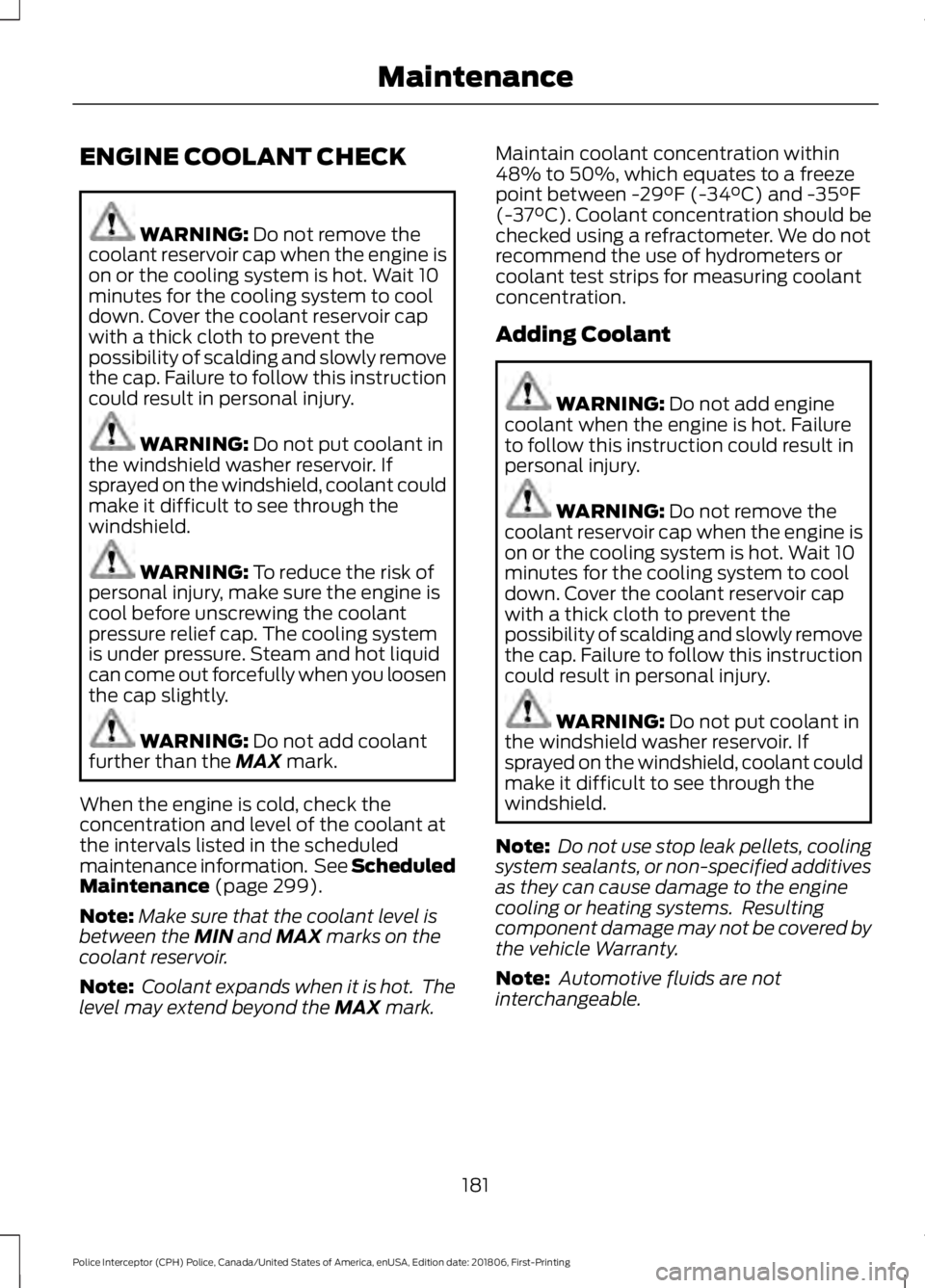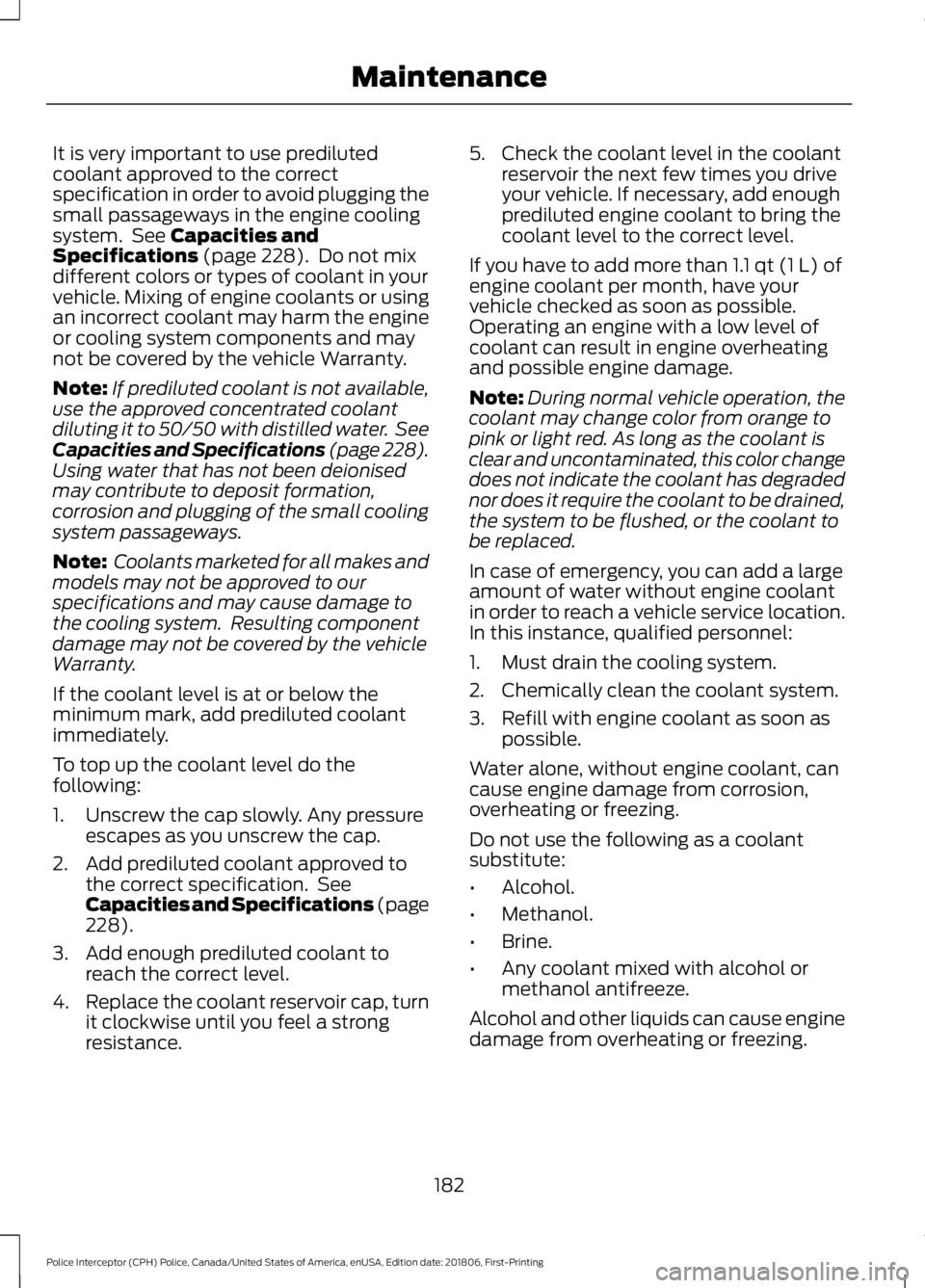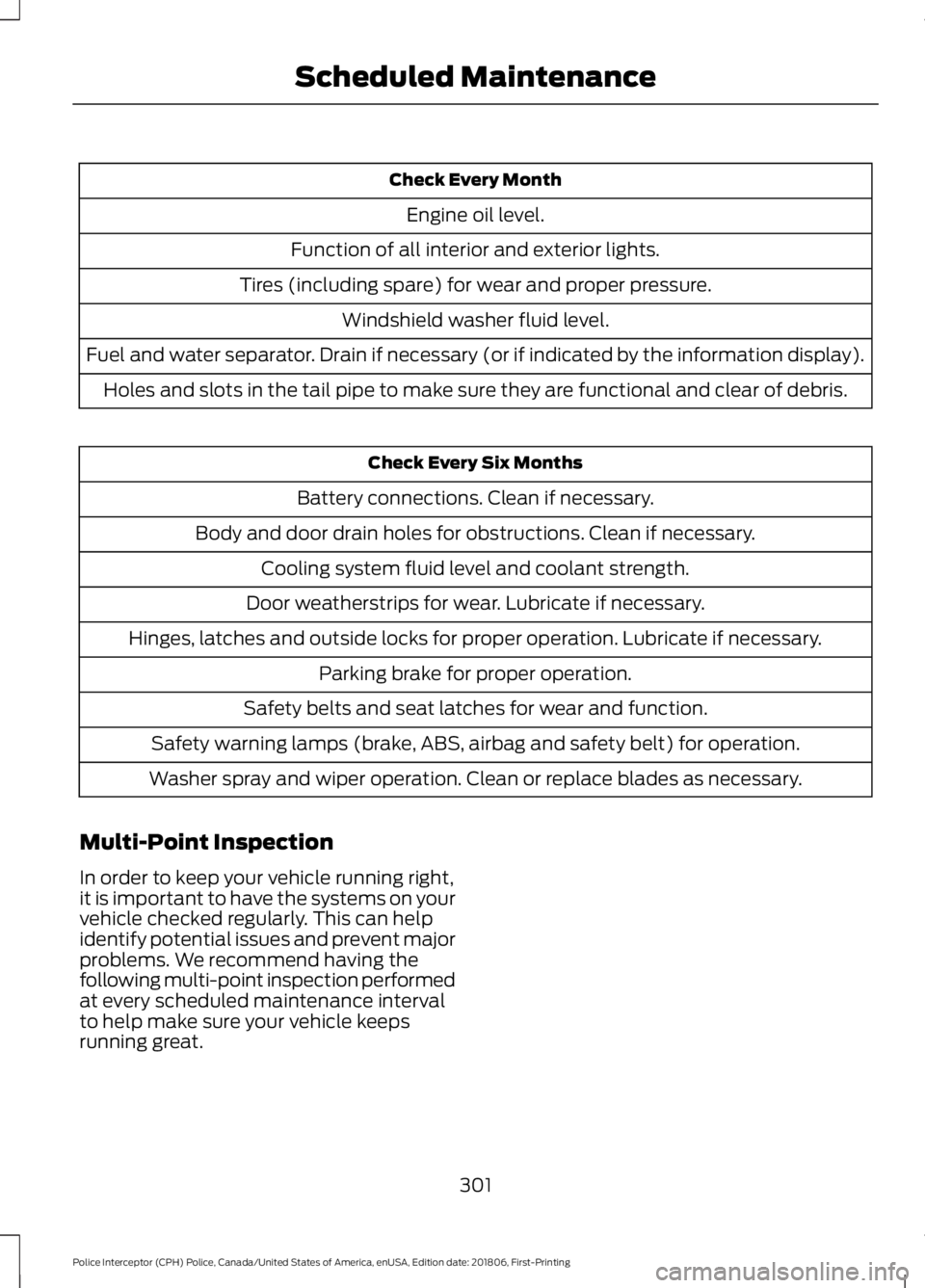2019 FORD POLICE INTERCEPTOR check engine light
[x] Cancel search: check engine lightPage 184 of 370

ENGINE COOLANT CHECK
WARNING: Do not remove the
coolant reservoir cap when the engine is
on or the cooling system is hot. Wait 10
minutes for the cooling system to cool
down. Cover the coolant reservoir cap
with a thick cloth to prevent the
possibility of scalding and slowly remove
the cap. Failure to follow this instruction
could result in personal injury. WARNING:
Do not put coolant in
the windshield washer reservoir. If
sprayed on the windshield, coolant could
make it difficult to see through the
windshield. WARNING:
To reduce the risk of
personal injury, make sure the engine is
cool before unscrewing the coolant
pressure relief cap. The cooling system
is under pressure. Steam and hot liquid
can come out forcefully when you loosen
the cap slightly. WARNING:
Do not add coolant
further than the MAX mark.
When the engine is cold, check the
concentration and level of the coolant at
the intervals listed in the scheduled
maintenance information. See Scheduled
Maintenance
(page 299).
Note: Make sure that the coolant level is
between the
MIN and MAX marks on the
coolant reservoir.
Note: Coolant expands when it is hot. The
level may extend beyond the
MAX mark. Maintain coolant concentration within
48% to 50%, which equates to a freeze
point between
-29°F (-34°C) and -35°F
(-37°C). Coolant concentration should be
checked using a refractometer. We do not
recommend the use of hydrometers or
coolant test strips for measuring coolant
concentration.
Adding Coolant WARNING:
Do not add engine
coolant when the engine is hot. Failure
to follow this instruction could result in
personal injury. WARNING:
Do not remove the
coolant reservoir cap when the engine is
on or the cooling system is hot. Wait 10
minutes for the cooling system to cool
down. Cover the coolant reservoir cap
with a thick cloth to prevent the
possibility of scalding and slowly remove
the cap. Failure to follow this instruction
could result in personal injury. WARNING:
Do not put coolant in
the windshield washer reservoir. If
sprayed on the windshield, coolant could
make it difficult to see through the
windshield.
Note: Do not use stop leak pellets, cooling
system sealants, or non-specified additives
as they can cause damage to the engine
cooling or heating systems. Resulting
component damage may not be covered by
the vehicle Warranty.
Note: Automotive fluids are not
interchangeable.
181
Police Interceptor (CPH) Police, Canada/United States of America, enUSA, Edition date: 201806, First-Printing Maintenance
Page 185 of 370

It is very important to use prediluted
coolant approved to the correct
specification in order to avoid plugging the
small passageways in the engine cooling
system. See Capacities and
Specifications (page 228). Do not mix
different colors or types of coolant in your
vehicle. Mixing of engine coolants or using
an incorrect coolant may harm the engine
or cooling system components and may
not be covered by the vehicle Warranty.
Note: If prediluted coolant is not available,
use the approved concentrated coolant
diluting it to 50/50 with distilled water. See
Capacities and Specifications (page 228).
Using water that has not been deionised
may contribute to deposit formation,
corrosion and plugging of the small cooling
system passageways.
Note: Coolants marketed for all makes and
models may not be approved to our
specifications and may cause damage to
the cooling system. Resulting component
damage may not be covered by the vehicle
Warranty.
If the coolant level is at or below the
minimum mark, add prediluted coolant
immediately.
To top up the coolant level do the
following:
1. Unscrew the cap slowly. Any pressure escapes as you unscrew the cap.
2. Add prediluted coolant approved to the correct specification. See
Capacities and Specifications (page
228
).
3. Add enough prediluted coolant to reach the correct level.
4. Replace the coolant reservoir cap, turn
it clockwise until you feel a strong
resistance. 5. Check the coolant level in the coolant
reservoir the next few times you drive
your vehicle. If necessary, add enough
prediluted engine coolant to bring the
coolant level to the correct level.
If you have to add more than
1.1 qt (1 L) of
engine coolant per month, have your
vehicle checked as soon as possible.
Operating an engine with a low level of
coolant can result in engine overheating
and possible engine damage.
Note: During normal vehicle operation, the
coolant may change color from orange to
pink or light red. As long as the coolant is
clear and uncontaminated, this color change
does not indicate the coolant has degraded
nor does it require the coolant to be drained,
the system to be flushed, or the coolant to
be replaced.
In case of emergency, you can add a large
amount of water without engine coolant
in order to reach a vehicle service location.
In this instance, qualified personnel:
1. Must drain the cooling system.
2. Chemically clean the coolant system.
3. Refill with engine coolant as soon as possible.
Water alone, without engine coolant, can
cause engine damage from corrosion,
overheating or freezing.
Do not use the following as a coolant
substitute:
• Alcohol.
• Methanol.
• Brine.
• Any coolant mixed with alcohol or
methanol antifreeze.
Alcohol and other liquids can cause engine
damage from overheating or freezing.
182
Police Interceptor (CPH) Police, Canada/United States of America, enUSA, Edition date: 201806, First-Printing Maintenance
Page 304 of 370

Check Every Month
Engine oil level.
Function of all interior and exterior lights.
Tires (including spare) for wear and proper pressure. Windshield washer fluid level.
Fuel and water separator. Drain if necessary (or if indicated by the information display). Holes and slots in the tail pipe to make sure they are functional and clear of debris. Check Every Six Months
Battery connections. Clean if necessary.
Body and door drain holes for obstructions. Clean if necessary. Cooling system fluid level and coolant strength.
Door weatherstrips for wear. Lubricate if necessary.
Hinges, latches and outside locks for proper operation. Lubricate if necessary. Parking brake for proper operation.
Safety belts and seat latches for wear and function.
Safety warning lamps (brake, ABS, airbag and safety belt) for operation.
Washer spray and wiper operation. Clean or replace blades as necessary.
Multi-Point Inspection
In order to keep your vehicle running right,
it is important to have the systems on your
vehicle checked regularly. This can help
identify potential issues and prevent major
problems. We recommend having the
following multi-point inspection performed
at every scheduled maintenance interval
to help make sure your vehicle keeps
running great.
301
Police Interceptor (CPH) Police, Canada/United States of America, enUSA, Edition date: 201806, First-Printing Scheduled Maintenance
Page 363 of 370

System Errors.......................................................
133
System Limitations............................................ 133
Using the System................................................ 132
BLIS See: Blind Spot Information System...........132
Bonnet Lock See: Opening and Closing the Hood............175
Booster Seats..................................................25 Types of Booster Seats...................................... 26
Brake Fluid Check........................................188
Brakes...............................................................120 General Information.......................................... 120
Breaking-In......................................................149
Bulb Specification Chart...........................247
C
Cabin Air Filter.................................................85
Capacities and Specifications - 3.5L Duratec.........................................................235
Alternative Engine Oil for Extremely Cold Climates........................................................... 238
Specifications...................................................... 235
Capacities and Specifications - 3.5L Ecoboost™.................................................238
Alternative Engine Oil for Extreme Cold Climates........................................................... 242
Specifications..................................................... 239
Capacities and Specifications - 3.7L.................................................................243
Alternative Engine Oil for Extremely Cold Climates........................................................... 246
Specifications..................................................... 244
Capacities and Specifications................228
Car Wash See: Cleaning the Exterior............................... 196
Catalytic Converter......................................107 On-Board Diagnostics (OBD-II)................... 108
Readiness for Inspection and Maintenance (I/M) Testing................................................... 108
Center Console
................................................91
Console Mounting Plates................................... 91
Universal Top Tray................................................ 91
Changing a Bulb
............................................193
Front Fog Lamp................................................... 193
High-Intensity Discharge Headlamps.........193
LED Lamps............................................................ 194
License Plate Lamp........................................... 194Changing a Fuse............................................173
Fuses........................................................................\
173
Changing a Road Wheel............................222 Dissimilar Spare Wheel and Tire Assembly
Information...................................................... 222
Tire Change Procedure.................................... 223
Changing the 12V Battery..........................189 Battery Management System......................... 191
Changing the Engine Air Filter.................194
Changing the Wiper Blades......................192
Checking the Wiper Blades.......................191
Child Restraint and Seatbelt Maintenance.................................................35
Child Restraint Positioning
..........................27
Child Safety.......................................................18
General Information............................................. 18
Cleaning Leather Seats.............................200
Cleaning Products.......................................196 Materials................................................................ 196
Cleaning the Engine
....................................198
Cleaning the Exterior...................................196 Cleaning the Headlamps................................. 197
Exterior Chrome Parts....................................... 197
Exterior Plastic Parts......................................... 197
Stripes or Graphics............................................. 197
Underbody............................................................. 197
Under Hood........................................................... 197
Cleaning the Instrument Panel and Instrument Cluster Lens.........................199
Cleaning the Interior....................................199 Mirrors..................................................................... 199
Cleaning the Wheels...................................201
Cleaning the Windows and Wiper Blades............................................................198
Climate Control
..............................................83
Coolant Check See: Engine Coolant Check............................. 181
Crash Sensors and Airbag Indicator
........45
Airbags and Police Equipment....................... 46
Cross Traffic Alert.........................................134 False Alerts........................................................... 136
Switching the System Off and On...............136
System Errors....................................................... 136
System Lights, Messages and Audible Alerts.................................................................. 135
System Limitations............................................ 136
Using the System................................................ 134
360
Police Interceptor (CPH) Police, Canada/United States of America, enUSA, Edition date: 201806, First-Printing Index
Page 370 of 370

System Indicator Lights and
Messages.......................................................... 123
Using a Switch..................................................... 123
Using the Information Display Controls............................................................. 123
Using Voice Recognition...........................259
Initiating a Voice Session................................ 259
System Interaction and Feedback..............260
Utilizing the Mediation/Arbitration Program (Canada Only).........................160
V
Vehicle Care...................................................196 General Information.......................................... 196
Vehicle Certification Label.......................234
Vehicle Identification Number
................233
Vehicle Storage.............................................201
Battery................................................................... 202
Body........................................................................\
. 201
Brakes.................................................................... 202
Cooling system................................................... 202
Engine.................................................................... 202
Fuel system.......................................................... 202
General................................................................... 201
Miscellaneous..................................................... 202
Removing Vehicle From Storage.................202
Tires........................................................................\
202
Ventilation See: Climate Control........................................... 83
VIN See: Vehicle Identification Number............233
Voice Control....................................................57
W
Warning Lamps and Indicators..................71 Airbag readiness.................................................... 71
Anti-Lock Braking System.................................. 71
Brake System.......................................................... 71
Charging System.................................................... 71
Cruise Control......................................................... 71
Direction Indicator................................................ 72
Door Ajar.................................................................. 72
Engine Coolant Temperature........................... 72
Engine Oil................................................................. 72
Fasten Seatbelt..................................................... 72
High Beam............................................................... 72Low Fuel Level.......................................................
72
Low Tire Pressure Warning................................ 72
Low Washer Fluid................................................. 72
Parking Lamps....................................................... 72
Police Engine Idle feature.................................. 72
Powertrain Fault.................................................... 73
Service Engine Soon............................................ 73
Stability Control.................................................... 73
Stability Control Off............................................. 73
Washer Fluid Check.....................................189
Washers See: Cleaning the Exterior............................... 196
Waxing..............................................................198
Wheel Nuts See: Changing a Road Wheel........................ 222
Wheels and Tires
.........................................204
General Information......................................... 204
Technical Specifications................................. 226
Windows and Mirrors
...................................66
Windshield Washers.....................................60
Windshield Wipers........................................60
Speed Dependent Wipers................................ 60
Wiper Blades See: Checking the Wiper Blades.................... 191
Wipers and Washers....................................60
367
Police Interceptor (CPH) Police, Canada/United States of America, enUSA, Edition date: 201806, First-Printing Index